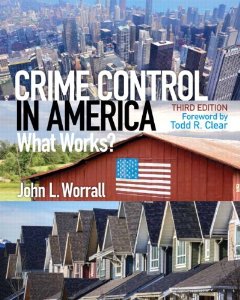Test Bank for Crime Control in America What Works 3rd Edition John L Worrall Download
$35.00 Original price was: $35.00.$26.50Current price is: $26.50.
Test Bank for Crime Control in America What Works 3rd Edition John L Worrall Download
Test Bank for Crime Control in America What Works 3rd Edition John L Worrall Download

Product details:
- ISBN-10 : 0134848187
- ISBN-13 : 978-0134848181
- Author: John L. Worrall
Crime Control in America: What Works? provides comprehensive coverage of what works in policing, prosecution, courts, and legislative methods of crime control. It also moves beyond the justice system and examines the effectiveness of crime control at the individual, family, school, and community levels. Finally, it covers environmental criminology and explanations of large-scale crime trends. The 4th edition includes new sections covering the most current and controversial topics in crime control, including the alleged Ferguson effect, immigration enforcement, raising the age of majority, and mass shootings.
Table contents:
PART 1: INTRODUCTION
1. Identifying and Evaluating Crime Control
Crime Control and Prevention
The Crime Problem in America
Types of Crimes
The Ever-Expanding Criminal Law
Incidence of Crime
Costs of Crime and Criminals
Is Fear of Crime Worse Than Crime Itself?
Approaches, Not Just Policies
Laws
Official Policies, Written and Unwritten
Unofficial Approaches
On the Importance of Definitions
Defining the Crime Problem
Defining the Solution
Defining the Desired Outcome
Evaluating Success: An Impossible Task?
The Hard and Soft Sciences
The Elusive Criminal Justice Experiment
You Can Prove Anything with Statistics
Qualitative and Quantitative Research
Macro- and Micro-Level Crime Control
Displacement and Diffusion
Measuring Displacement and Diffusion
The Tentative Nature of Scientific Knowledge
The Measures Used
When New Data Become Available
Alternative Settings: The Generalization Problem
Other Concerns
Funding and Political Priorities
Academic Crusaders and Bandwagon Science
Evidence-Based Justice
Effective Does Not Always Mean Best
A Preview of the Book
Guns and Drugs: The Real Attention Getters
Summary
Notes
2. Crime Control Perspectives
Operational Perspectives
Due Process and Crime Control
Due Process Values
Crime Control Values
System and Nonsystem
A Well-Oiled Machine?
A Disorganized Mess?
The Funnel Model of Justice
The Criminal Justice Wedding Cake
Political Perspectives
Liberals and Conservatives
Causes of Crime
Consequences of Crime for Society
What Should Be Done About Crime?
Consensus and Conflict
Causes of Crime
Consequences of Crime for Society
What Should Be Done About Crime?
Other Perspectives
Faith and Fact
Crime Control and Revenue Generation
Politics and Ivory Towers
Goals of Crime Control
Deterrence
General and Specific Deterrence
Absolute and Marginal Deterrence
The Limitations of Deterrence
Retribution
The Limitations of Retribution
Incapacitation
The Limitations of Incapacitation
Rehabilitation
The Limitations of Rehabilitation
Goals of Crime Control Compared
Summary
Notes
PART 2: LAW ENFORCEMENT APPROACHES
3. Traditional Policing
The Theory of Traditional Policing
Does Hiring More Cops Reduce Crime?
Reasons Why Hiring More Cops Might Not Reduce Crime
Lessons from Kansas City
Misinterpretations
Criticisms
The Post-Kansas City Intellectual Debate
The Violent Crime Control Act of 1994
What Happens When the Police Go on Strike?
De-Policing and the Alleged “Ferguson Effect”
A Very Thin Blue Line: Is There Really a Police Presence?
What Are They Doing on the Job?
Does It Work?
Freeing up Resources
One- versus Two-Officer Patrols
311
Patrol Downtime Studies
Does It Work?
Reactive Policing and Random Patrol
Reactive Policing
Domestic Violence Arrests
Rapid Response
Random Patrol
Does It Work?
Detective Work and Crime
The RAND Study
Recent Developments
Does It Work?
Private Policing
Private Security versus Private Policing
Controversies in Private Policing
Does It Work?
College Degrees for Cops
Does It Work?
Summary
Notes
4. Proactive Policing, Directed Patrol, and Recent Advancements
Proactive Arrests
Proactive Arrests for High-Risk Repeat Offenders
Proactive Arrests for Specific Offenses
Targeting Drug Offenders
Targeting Drunk Drivers
Targeting Immigrants
Does It Work?
Directed Patrol
Classic Studies
Lawrence Sherman and the Hot Spots
Directed Patrol of Drug Hot Spots
Directed Patrol of Gun Violence Hot Spots
Stop, Question, and Frisk
Stop, Question, and Frisk: Effects on Crime
Does It Work?
Broken Windows and Disorder Reduction
Fear, Disorder, and Crime
Quality-of-Life Policing
Micro-Level Research
Macro-Level Research
Disorder Reduction
Missing the Boat on Broken Windows
Does It Work?
Focused Deterrence
Group Violence Reduction
Does It Work?
Partnering
Police–Corrections Partnerships
What Does the Research Show?
Multijurisdictional Drug Task Forces
Military Partnerships and Militarization
The Police–Military Connection
Police Paramilitary Units
Does It Work?
Technology and Less-Lethal Weapons
Safely Ending Pursuits
Crime Detection Devices
Less-Lethal Weapons
Conducted Energy Devices
Does It Work?
Using Data to Inform Decisions
COMPSTAT
Fusion Centers and Intelligence-Led Policing
Predictive Policing
Does It Work?
Summary
Notes
5. Community Involvement in Policing
Fixing Strained Police-Community Relations
Procedural Justice
The President’s Task Force on 21st Century Policing
Community Justice
Problem-Oriented Policing
Community Policing: Some History
Reasons for Community Policing
Community Policing: What Is It?
The Definition Problem Rears Its Head
Community Policing: Is It Really Happening?
Structural Change
Attitudinal Change
Research on Community Policing Effectiveness
Moving the Police into the Community
Citizen Contact Patrol
Improving the Police Image
Organizing Neighborhood Watch Programs
Hosting Community Meetings
Disseminating Crime Control Newsletters
Storefronts and Substations
Specialized Patrols
Operation Identification
Police-Sponsored Television and Websites
Police in Schools
Does It Work?
Integrated Community Policing
The Seattle Approach
The Hartford Approach
Does It Work?
Bringing the Community to the Police
Citizen Patrol
Citizen Police Academies
Does It Work?
Third-Party Policing
Beyond the Criminal Law
Some Examples of Third-Party Policing
Does It Work?
Summary
Notes
6. Prosecutors and Crime Control
Prosecutors
The Shift Toward Strategic Prosecution
The Harder Side of Prosecution
No-Drop Prosecution Policies
Juvenile Waiver
Raising the Age of Majority: A Retreat from Waiver?
Police-Prosecution Partnerships
Partnering to Reduce Gun Violence
Federal-State Partnerships
Richmond’s, Virginia, Project Exile
Texas Exile
Project Safe Neighborhoods
Cross-Designation
Does It Work?
The Softer Side of Prosecution
Victim Assistance
Community Prosecution
The Structure of Community Prosecution
Nontraditional Restraining Orders
Code Enforcement
Nuisance Abatement
Forfeiture
Community Prosecution Research
Deferred Prosecution
Deferred Sentencing
Does It Work?
A Plea Bargaining Pandemic?
Arguments for and Against Plea Bargaining
Attempts to Limit Plea Bargaining
Ad Hoc Plea Bargaining
Does It Work?
Summary
Notes
PART 3: LEGISLATION, COURTS, AND CORRECTIONS
7. Crime Control Through Legislation
Legislative Bans
Where There’s a Demand, There’s a Supply
Historical Lessons
Gambling and Prostitution
Prohibition
Bans and Their Enforcement
Gun Bans
Ban Specific Guns and Gun Possession
Drug Bans
The Scope of America’s Drug Problem
Drug Ban Problems
Does It Work?
Legislative Gun Controls
Altering Gun Designs
Regulating Gun Transactions
Denying Gun Ownership to Dangerous Persons
Buybacks
The Right-to-Carry Controversy
Concealed Carry Laws
Does It Work?
Public Notification and Related Laws
Megan’s Law
Legal Issues
Effects on Crime
Punitive Sanctions for Sex Offenders
Sex Offender Residency Restrictions
Does It Work?
Other Legislative Approaches
White-Collar Crime Laws
Does It Work?
Antiterrorism Laws
The USA Patriot Act
The USA Freedom Act
Does It Work?
Summary
Notes
8. Crime Control in the Courts and Beyond
Courts and Incapacitation
Pretrial Incapacitation
Preventive Detention
Setting Bail at a High Level
Does It Work?
Diversion
Examples of Programmatic Diversion
Diversion Evaluations
Does It Work?
Shaming
A Brief History of Shaming
Examples of Shaming Penalties
Public Exposure Penalties
Debasement Penalties
Apology Penalties
Reverse Burglary?
Criticisms of Shaming
Braithwaite’s Reintegrative Shaming
Shaming and Recidivism
Does It Work?
Restorative Justice
Examples of Restorative Justice
What the Research Shows
Does It Work?
Antigang Injunctions
Does It Work?
Problem-Solving Courts
Drug Courts
Possible Limitations of Drug Courts
The Empirical Evidence
Domestic Violence Courts
Therapeutic Jurisprudence
A Domestic Violence Court in Operation
The Evidence
Community Courts
The Midtown Community Court
The Research
Teen Courts
Other Specialized Courts
Homeless Courts
Mental Health Courts
Reentry Courts
Does It Work?
Summary
People also search:
crime control in america what works
crime control in america what works 4th edition pdf free
crime control in america what works 4th edition pdf
crime control in america what works 4th edition











